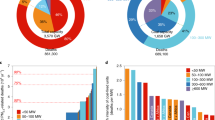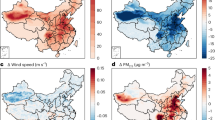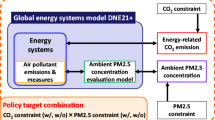Abstract
Recently, South Korea announced it would make efforts to achieve net-zero emissions by 2050. Korea already has been working to reduce greenhouse gas (GHG) emissions with diverse policies and measures in many sectors. However, climate change is not the only environmental issue that is a concern for South Korea. Annual average PM2.5 concentrations were 23μg/m3 in 2018 and 2019 (National Institute of Environmental Research 2020). National emission standards for PM2.5 have been exeeded over 50 times in 2018 and 2019. It is expected that annual premature mortality associated with PM2.5 will be the highest among Organisation of Economic Co-operation and Development (OECD) countries (OECD 2017). The South Korean government has to deal with these two serious environmental and health risks like many other countries. Co-control policies to reduce PM2.5 and GHGs simultaneously therefore have become a priority for South Korea. Carefully designed co-control and co-benefit policies would help to resolve these problems in more cost-efficive manner. Policies that promote renewable energy have the potential to deliver these co-benefits. Increasing the share of renewable energy to replace coal-fired power generation is included in both South Korea’s Amendment to the Roadmap for the National GHG Reduction for 2030 and the Comprehensive Plan on Fine Dust Management.
Access this chapter
Tax calculation will be finalised at checkout
Purchases are for personal use only
Similar content being viewed by others
Notes
- 1.
The full CTM approach to analyze the change of the ambient concentration needs running a CTM model for each case. However, it requires enough in terms of expertise, time, and resources (Gilmore et al. 2019).
- 2.
We finally used the value of KRW 3 billion derived through the benefit-transfer method.
References
Ahn CY et al (2018) Estimation of social costs of air pollutants. KEI Focus 7(6):11
Dimanchev EG, Paltsev S, Yuan M, Rothenberg D, Tessum CW, Marshall JD, Selin NE (2019) Health co-benefits of sub-national renewable energy policy in the US. Environ Res Lett 14. https://doi.org/10.1088/1748-9326/ab31d9
EPA (2018) Quantifying the multiple benefits of energy efficiency and renewable energy: a guide for state and local governments 1–17
Garrett-Peltier H (2017) Green versus brown: comparing the employment impacts of energy efficiency, renewable energy, and fossil fuels using an input-output model. Econ Model 61:439–447. https://doi.org/10.1016/j.econmod.2016.11.012
Gilmore EA, Heo J, Muller NZ, Tessum CW, Hill JD, Marshall JD, Adams PJ (2019) An inter-comparison of the social costs of air quality from reduced-complexity models. Environ Res Lett 14. https://doi.org/10.1088/1748-9326/ab1ab5
Hoek G, Krishnan RM, Beelen R, Peters A, Ostro B, Brunekreef B, Kaufman JD (2013) Long-term air pollution exposure and cardio- respiratory mortality: a review. Environ Health 12:43. https://doi.org/10.1186/1476-069X-12-43
IEA (2018) World Energy Outlook 2018. Int. Energy Agency
IEA (2019) Renewables 2019: Analysis and forecast to 2024. Int. Energy Agency
IEA (2020a) World Energy Outlook 2020. Int. Energy Agency
IEA (2020b) Sustainable recovery: world energy outlook special report. World Energy Outlook 185
IQAir (2019) World Air Quality Report. 2019 World Air Qual Rep 1–22
IRENA (2018) Global energy transformation: a roadmap to 2050, global energy transformation. A Roadmap to 2050
IRENA (2019) Renewable Power Generation Costs in 2019
IRENA (2020) Measuring the socio-economics of transition: Focus on jobs, International Renewable Energy Agency, Abu Dhab
IWG (2016) Technical Support Document:-Technical Update of the Social Cost of Carbon for Regulatory Impact Analysis-Under Executive Order 12866
Lee GD, Park MD, Jeon YJ, Shin HC, Yang JH, Kim YK, Park HJ (2018) “A study on estimation of levelized cost of electricity by source” in Korean
Luderer G, Pehl M, Arvesen A, Gibon T, Bodirsky BL, de Boer HS, Fricko O, Hejazi M, Humpenöder F, Iyer G, Mima S, Mouratiadou I, Pietzcker RC, Popp A, van den Berg M, van Vuuren D, Hertwich EG (2019) Environmental co-benefits and adverse side-effects of alternative power sector decarbonization strategies. Nat Commun 10:1–13. https://doi.org/10.1038/s41467-019-13067-8
MoE (2019) Comprehensive plan on fine dust management
Muller NZ, Mendelsohn R (2006) The air pollution emission experiments and policy analysis model (APEEP)
National Institute of Environmental Research (2020) Annual report of air quality in Korea 2020
OECD (2017) OECD Environmental Performance Reviews: Korea 2017
OECD (2020) Making the Green Recovery work for jobs, income and growth. OECD, Paris, pp 21–32
Author information
Authors and Affiliations
Corresponding author
Editor information
Editors and Affiliations
Rights and permissions
Copyright information
© 2021 The Author(s), under exclusive license to Springer Nature Singapore Pte Ltd.
About this chapter
Cite this chapter
Jeon, HC., Kim, Y.J., Chae, Y. (2021). Quantifying and Integrating Co-benefits of Renewable Energy Policies in South Korea. In: Farzaneh, H., Zusman, E., Chae, Y. (eds) Aligning Climate Change and Sustainable Development Policies in Asia. Springer, Singapore. https://doi.org/10.1007/978-981-16-0135-4_5
Download citation
DOI: https://doi.org/10.1007/978-981-16-0135-4_5
Published:
Publisher Name: Springer, Singapore
Print ISBN: 978-981-16-0134-7
Online ISBN: 978-981-16-0135-4
eBook Packages: Earth and Environmental ScienceEarth and Environmental Science (R0)




